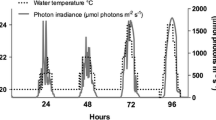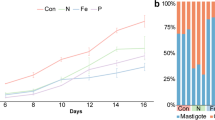Abstract
Corals exposed to environmental stresses need to engage appropriate physiological strategies to survive. Here, we examined tissue modifications following algal dysfunction. Aiptasia pallida was exposed during 1 week to 3-(3,4-dichlorophenyl)-1,1-dimethylurea (DCMU), the herbicide called diuron. DCMU treatment produced a drastic loss in photosynthetic efficiency and a subsequent diminution of algae density over the following days. Cell proliferation evaluated by measuring the number of cells labeled with a thymidine analogue (EdU) revealed a significant increase in EdU+ cells in the epidermis after 1 week of DCMU incubation and in the gastrodermis at 4 weeks. TUNEL histology showed that the extent of cell death was, however, similar in the epidermis of control and treated specimens. In addition, we noticed a significant effect of DCMU treatment on the density of epidermal mucocytes after 1, 2 and 4 weeks. These results show that inhibition of Symbiodinium photosynthesis in the absence of any known direct effect of DCMU on host cells can induce an increase in epidermal host cell proliferation in both the epidermis and the gastrodermis. While new host gastrodermal cells are likely to promote tissue regeneration in order to recruit new algae, the new host epidermal cells may contribute to tissue adaptation following a decrease in energy income. Some of these new epidermal cells, such as mucocytes, may contribute to an eventual increase in the host heterotrophic ability until restoration of algal autotrophic contribution.






Similar content being viewed by others
Abbreviations
- CHAR:
-
Contribution of heterotrophically acquired carbon to daily animal respiration
- DCMU:
-
3-(3,4-Dichlorophenyl)-1,1-dimethylurea
- EdU:
-
5-Ethynyl-2′-deoxyuridine
- EdU+:
-
5-Ethynyl-2′-deoxyuridine positive
- F 0 :
-
Initial fluorescence level
- F M :
-
Maximum fluorescence level
- ΦPSII:
-
Effective photochemical quantum yield
- PSII:
-
Photosystem II
References
Ainsworth TD, Hoegh-Guldberg O, Heron SF, Skirving WJ, Leggat W (2008) Early cellular changes are indicators of pre-bleaching thermal stress in the coral host. J Exp Mar Biol Ecol 364:63–71
Anthony KRN, Fabricius KE (2000) Shifting roles of heterotrophy and autotrophy in coral energetics under varying turbidity. J Exp Mar Biol Ecol 252:221–253
Banin E, Israely T, Fine M, Loya Y, Rosenberg E (2001) Role of endosymbiotic zooxanthellae and coral mucus in the adhesion of the coral-bleaching pathogen Vibrio shiloi to its host. FEMS Microbiol Lett 199:33–37
Bengtson Nash SM, McMahon K, Eaglesham G, Muller JF (2004) Application of a novel phytotoxicity assay for the detection of herbicides in Hervey Bay and the great sandy straits. Mar Pollut Bull 51:351–360
Brown BE, Bythell JC (2005) Perspectives on mucus secretion in reef corals. MEPS 296:291–309
Brown BE, Dunne RP, Ambarsari I, Le Tissier MDA, Satapoomin U (1999) Seasonal fluctuations in environmental factors and variations in symbiotic algae and chlorophyll pigments in four Indo-Pacific coral species. MEPS 191:53–69
Cantin NE, Negri AP, Willis BL (2007) Photoinhibition from chronic herbicide exposure reduces reproductive output of reef-building corals. MEPS 344:81–93
Davy SK, Allemand D, Weis VM (2012) Cell biology of cnidarian-dinoflagellate symbiosis. Microbiol Mol Biol Rev 76:229–261
Ducommun P, Ruffieux PA, Kadouri A, Von Stockar U, Marison IW (2002) Monitoring of temperature effects on animal cell metabolism in a packed bed process. Biotechnol Bioeng 77:838–842
Dunn SR, Thomason JC, Le Tissier MDA, Bythell JC (2004) Heat stress induces different forms of cell death in sea anemones and their endosymbiotic algae depending on temperature and duration. Cell Death Differ 11:1213–1222
Fagoonee I, Wilson HB, Hassell MP, Turner JR (1999) The dynamics of zooxanthellae populations: a long-term study in the field. Science 283:843–845
Ferrier-Pagès C, Rottier C, Beraud E, Levy O (2010) Experimental assessment of the feeding effort of three scleractinian coral species during a thermal stress: effect on the rates of photosynthesis. J Exp Mar Biol Ecol 390:118–124
Ferrier-Pagès C, Peirano A, Abbate M, Cocito S, Negri A, Rottier C, Riera P, Rodolfo-Metalpa R, Reynaud S (2011) Summer autotrophy and winter heterotrophy in the temperate symbiotic coral Cladocora caespitosa. Limnol Oceanogr 56:1429–1438
Fransolet D, Roberty S, Plumier JC (2012) Establishment of endosymbiosis: the case of cnidarians and Symbiodinium. J Exp Mar Biol Ecol 420–421:1–7
Fransolet D, Roberty S, Herman AC, Tonk L, Hoegh-Guldberg O, Plumier JC (2013) Increased cell proliferation and mucocyte density in the sea anemone Aiptasia pallida recovering from bleaching. PLoS One 8:e65015
Gates RD, Ainsworth TD (2011) The nature and taxonomic composition of coral symbiomes as drivers of performance limits in scleractinian corals. J Exp Mar Biol Ecol 408:94–101
Gold DA, Jacobs DK (2013) Stem cell dynamics in cnidaria: are there unifying principles? Dev Genes Evol 223:53–66
Grottoli AG, Rodrigues LJ, Juarez C (2004) Lipids and stable carbon isotopes in two species of Hawaiian corals Porites compressa and Montipora verrucosa following a bleaching event. Mar Biol 145:621–631
Grottoli AG, Rodrigues LJ, Palardy JE (2006) Heterotrophic plasticity and resilience in bleached corals. Nature 440:1186–1189
Hoegh-Guldberg O, Mumby PJ, Hooten AJ, Steneck RS, Greenfield P, Gomez E, Harvell CD, Sale PF, Edwards AJ, Caldeira K et al (2007) Coral reefs under rapid climate change and ocean acidification. Science 318:1737–1742
Hoogenboom M, Rodolfo-Metalpa R, Ferrier-Pagès C (2010) Co-variation between autotrophy and heterotrophy in the mediterranean coral Cladocora caespitosa. J Exp Biol 213:2399–2409
Houlbreque F, Ferrier-Pagès C (2009) Heterotrophy in tropical scleractinian corals. Biol Rev 84:1–17
Hughes TP, Baird AH, Bellwood DR, Card M, Connolly SR, Folke C, Grosberg R, Hoegh-Guldberg O, Jackson JBC, Kleypas J et al (2003) Climate change human impacts and the resilience of coral reefs. Science 301:929–933
Jones RJ, Kerswell AP (2003) Phytotoxicity of photosystem II (PSII) herbicides to coral. MEPS 261:149–159
Jones RJ, Muller J, Haynes D, Schreiber U (2003) Effects of herbicides diuron and atrazine on corals of the great barrier reef Australia. MEPS 251:153–167
Konstantinou IK, Albanis TA (2004) Worldwide occurrence and effects of antifouling paint booster biocides. Environ Int 30:235–248
McMahon K, Bengtson Nash SM, Eaglesham G, Muller JF, Duke N, Winderlich S (2004) Herbicide contamination and the potential impact to seagrass meadows in Hervey Bay, Queensland, Australia. Marine Pollut Bull 51:325–334
Muscatine L (1990) The role of symbiotic algae in carbon and energy flux in reef corals. In: Dubinsky Z (ed) Coral reefs ecosystems of the world, vol 25. Elsevier, Amsterdam, pp 75–87
Oliver JK, Berkelmans R, Eakin CM (2009) Coral bleaching in space and time. In: van Oppen MJH, Lough JM (eds) Coral bleaching—patterns processes causes and consequences, ecological studies, vol 205., SpringerBerlin, Heidelberg, pp 21–39
Passamaneck YJ, Martindale MQ (2012) Cell proliferation is necessary for the regeneration of oral structures in the anthozoan cnidarian Nematostella vectensis. BMC Dev Biol 12:34
Paxton CW, Davy SK, Weis VM (2013) Stress and death of cnidarian host cells play a role in cnidarian bleaching. J Exp Biol 216:2813–2820
Pernice M, Dunn SR, Miard T, Dufour S, Dove S, Hoegh-Guldberg O (2011) Regulation of apoptotic mediators reveals dynamic responses to thermal stress in the reef building coral Acropora millepora. PLoS One 6:e16095
Piggot AM, Fouke BW, Sivaguru M, Sanford RA, Gaskins HR (2009) Change in zooxanthellae and mucocyte tissue density as an adaptive response to environmental stress by the coral Montastraea annularis. Mar Biol 156:2379–2389
Richardson LL, Smith GW, Ritchie KB, Carlton RG (2001) Integrating microbiological, microsensor, molecular and physiologic techniques in the study of coral disease pathogenesis. Hydrobiologia 460:71–89
Ritchie KB (2006) Regulation of microbial populations by coral surface mucus and mucus-associated bacteria. MEPS 322:1–14
Sheppard C, Davy SK, Pilling GM (2009) The biology of coral reefs. Oxford University Press, New York
Shick JM, Romaine-Lioud S, Ferrier-Pagès C, Gattuso JP (1999) Ultraviolet-B radiation stimulates shikimate pathway-dependent accumulation of mycosporine-like amino acids in the coral Stylophora pistillata despite decreases in its population of symbiotic dinoflagellates. Limnol Oceanogr 44:1667–1682
Tchernov D, Kvitt H, Haramaty L, Bibbyd TS, Gorbunov MY, Rosenfeld H, Falkowski PG (2011) Apoptosis and the selective survival of host animals following thermal bleaching in zooxanthellate corals. Proc Natl Acad Sci USA 108:9905–9909
Vandermeulen JH, Davis ND, Muscatine L (1972) The effect of inhibitors of photosynthesis on zooxanthellae in corals and other marine invertebrates. Mar Biol 16:185–191
Warner ME, Fitt WK, Schmidt GW (1999) Damage to photosystem II in symbiotic dinoflagellates: a determinant of coral bleaching. Proc Natl Acad Sci USA 96:8007–8012
Weis VM (2008) Cellular mechanisms of cnidarian bleaching: stress causes the collapse of symbiosis. J Exp Biol 211:3059–3066
Yellowlees D, Rees TAV, Leggat W (2008) Metabolic interactions between algal symbionts and invertebrate hosts. Plant Cell Environ 31:679–694
Acknowledgments
We thank the two anonymous reviewers for their helpful comments and the laboratory of Oceanology (ULg) for the diving PAM. DF is a recipient of a F.R.I.A PhD Studentship. JCP was supported by funding from the F.R.S.-F.N.R.S. (FRFC 2.4.631.09) and from the University of Liège (C-13/22). PAM was funded by ULg C-10/78 Fonds Spéciaux—crédits classiques. The funders had no role in study design, data collection and analysis, decision to publish, or preparation of the manuscript.
Conflict of interest
The authors have declared that no conflict of interest.
Author information
Authors and Affiliations
Corresponding author
Additional information
Communicated by R. Hill.
David Fransolet and Stéphane Roberty have equally contributed to this article.
Rights and permissions
About this article
Cite this article
Fransolet, D., Roberty, S. & Plumier, JC. Impairment of symbiont photosynthesis increases host cell proliferation in the epidermis of the sea anemone Aiptasia pallida . Mar Biol 161, 1735–1743 (2014). https://doi.org/10.1007/s00227-014-2455-1
Received:
Accepted:
Published:
Issue Date:
DOI: https://doi.org/10.1007/s00227-014-2455-1




